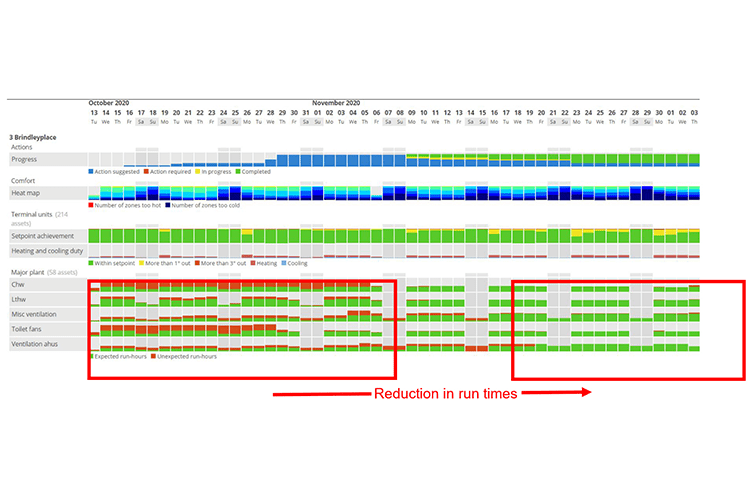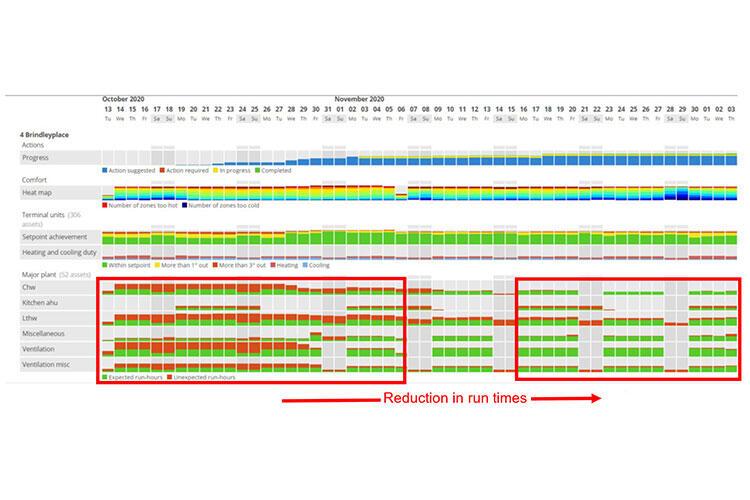Avison Young Advances Brindleyplace Towards Net Zero Carbon
15 July 2021Avison Young Advances Brindleyplace Towards Net Zero Carbon
15 July 2021At Brindleyplace in Birmingham, Avison Young has tested the power of live data intelligence to drive efficiency savings in managed properties. The installation of Demand Logic technology has cut carbon and reduced energy costs for occupiers, at the same time as highlighting interventions to improve comfort levels for wellbeing and productivity. With payback on investment within four months, the team is now looking at wider opportunities across the portfolio.
Key Facts
- 15% reduction in energy use
- £60,000 estimated annual savings
- 22 tonnes annual carbon savings
- ROI within four months
Situation
Avison Young is a specialist property adviser in the UK. It creates economic, social and environmental value. Brindleyplace is a 17-acre business and leisure destination in Birmingham, managed by Avison Young on behalf of asset managers Hines UK. Avison Young is committed to an occupational strategy of net zero carbon by 2030 and is continually looking at ways to deliver this across the managed estate.
To test the power of energy monitoring software to drive energy and carbon savings and reduce operational costs for occupiers, Avison Young piloted Demand Logic in two multi-let office buildings: Three and Four Brindleyplace. Results in the first two months were so impressive the team extended the technology to a third building: Nine Brindleyplace. Avison Young is now exploring wider opportunities for live data technologies across its portfolio.
Three and Four Brindleyplace were completed in 2001 and went through a £3 million upgrade in 2019. Also completed in 2001, Nine Brindleyplace has recently gone through a £3.8 million refurbishment. The three buildings are home to eight occupiers.
Actions
Demand Logic’s cloud-based software provides live intelligence on energy consumption in buildings. At Brindleyplace, it has identified problems that were not visible from the building management system alone, empowering property teams to quickly address issues.
Figure 1: Improvements to major plant run times out-of-hours at Three Brindleyplace
Figure 2: Improvements to major plant run times out-of-hours at Four Brindleyplace
The technology went online in October 2020 during a period of relatively low building occupancy, due to the global pandemic. This enabled the team to establish an accurate baseline for how low energy consumption could go.
Examples of issues fixed:
- The chilled water system at Four Brindleyplace was switching on out-of-hours, due to a faulty terminal unit calling for chilled water, even though the BMS was sending the central plant a message to switch off. Fixing this saved £2,800 within a few months. Estimated annual savings: £10,200 and four tonnes of carbon.
- Boilers at Three Brindleyplace were switching on at midnight, five hours earlier than programmed in the BMS, due to faulty fan coil units calling for heating. Fixing this saved over £2,000 within a few months. Estimated annual savings: £7,300 and three tonnes of carbon.
With the major plant running more efficiently, Avison Young is now able to step down a level and analyse the performance of individual areas of the buildings and of smaller items, such as fan coil units. Longer term, by using live data technologies, property teams will be able to implement more targeted maintenance regimes.
Financial
- Installation and annual fees are funded through the service charge. Return on investment for installation was achieved within four months through energy cost savings. Ongoing savings are set to more than cover annual fees, delivering additional savings to the service charge.
- 31 interventions actioned in the first five months, delivering an estimated annual savings of £60,000, with additional interventions in progress to deliver an extra £20,000 of annual savings.
- Further cost savings will be achieved through proactive maintenance, which will extend plant life.
Benefits
- 15% reduction in energy use in the first four months.
- Target of 200 tonnes of carbon savings annually, advancing Brindleyplace towards net zero.
- Identifying and addressing temperature errors and other comfort issues more quickly, contributing to wellbeing and productivity for occupiers.
- Putting Brindleyplace in a strong position for the return to the workplace post-Covid.
- Supporting sustainability goals for Avison Young, Hines UK and occupiers.
Challenges and Achievements
COSTS
How to justify investment?
The installation of live data technologies requires investment on the promise of savings, but generally without a guarantee. Demand Logic confirmed that they have never gone into a building and not made savings. Whilst this may happen at some point, Avison Young’s internal benchmarking indicated that there were savings to be made at Three, Four and Nine Brindleyplace, as energy consumption was running slightly higher than target for their size and type. The team therefore introduced the Demand Logic technology through the service charge, on the basis that it would reduce net costs and provide more efficient space for occupiers. As the team continues to gather data and as more people return to the workplace post-Covid, Avison Young will expand engagement with occupiers on savings opportunities.
BUY-IN
How to gain the buy-in of the maintenance team?
Getting the understanding and buy-in of the maintenance team is key. Early on, Avison Young and Demand Logic hosted presentations for the maintenance team, explaining what they were trying to achieve and emphasising that the system is a tool to assist everyone. It was helpful seeing the technology online, as it presents a complex, technical part of building management in a visual, easy to understand format. The errors highlighted were things the maintenance team would not have been able to see through the BMS. As a result, the engineers soon started to see the benefits of the system and have come to value the insights it provides. They now firmly believe in the power of the data provided by the technology.
*Please note that the information on this page was supplied by the BBP Member and the BBP assumes no responsibility or liability for any errors or omissions in the content


